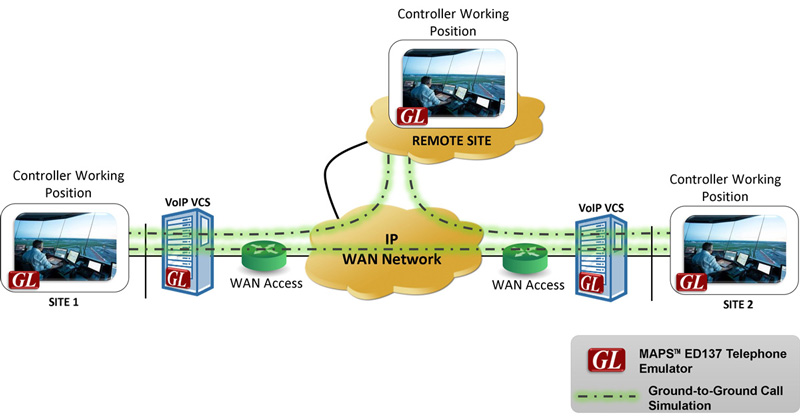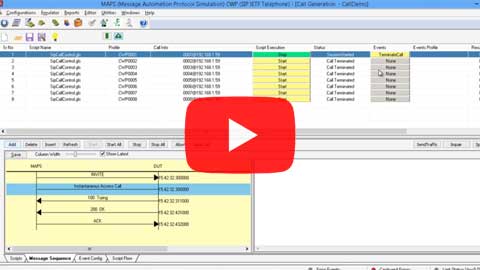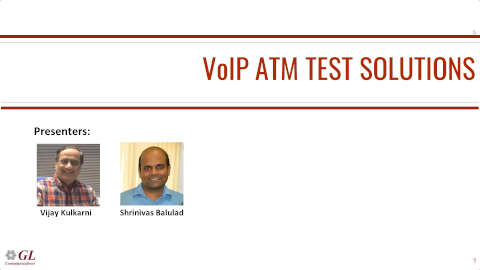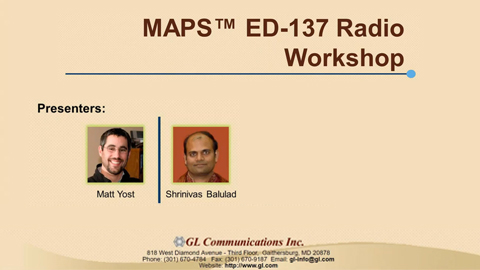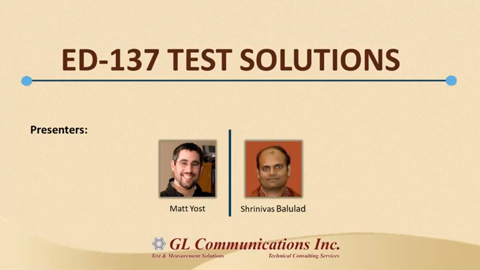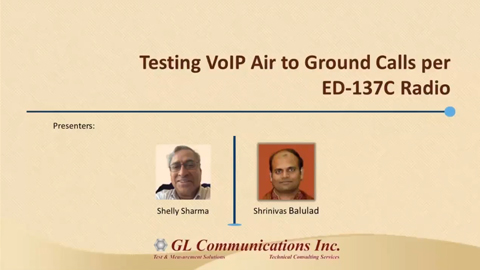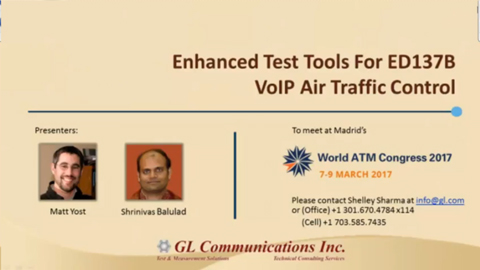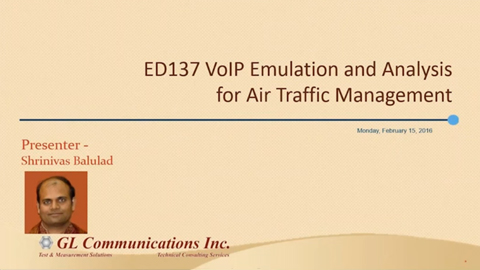MAPS™ ED-137 Telephone Emulator
MAPS™ ED137 Telephone - Simulates the functions of Controller Working Position (CWP) in Ground-to-Ground telephone calls
Request a Demo / Quote BrochureOverview
Recent advances in Air Traffic Management over IP network has opened both opportunities for providing better services, and challenges to ensure reliability, and performance. Among many other solutions for testing Air Traffic Control network, GL offers MAPS™ ED-137 Telephone (PKS119) which can simulate Ground-Ground calls. MAPS™ ED-137 supports VoIP implementation as per ED-137/2B and ED-137/2C- of EUROCAE (European Organization for Civil Aviation Equipment) standards.
MAPS™ ED-137 Telephone simulates the functions of Controller Working Position (CWP) in Ground-to-Ground telephone calls. The product supports transmission and detection of various RTP audio traffic such as real-time audio, voice file, digits, single tone and dual tones. The MAPS™ profile editor feature allows users to easily configure multiple CWPs profiles, allowing to simulate multiple CWP entities.

MAPS™ ED-137 Telephone now supports below addendums optionally.
- Addendum 2: FAA Legacy Telephone Interworking
- Addendum 4: Override Call
- Addendum 5: Voice Call
Application is also enhanced to support additional call scenarios such as Call Pick-up, Preset Conference call and Broadcast conference call.
GL tools for signaling emulation and voice quality testing offer an end-to-end test solution for testing connections from the radio interfaces to the Controller Working Position (CWP) and recording voice communications in the ATM network. GL’s Air Traffic Management Solution also includes MAPS™ ED-137 Recorder Emulator and MAPS™ ED-137 Radio Emulator.
GL also provides a GUI based PacketScan - All IP Traffic Analyzer for online capture and decode of the signaling in real time both during tests and as a stand-alone tracer for live systems.
Main Features
Signaling and Traffic Simulation |
|
Traffic |
|
GUI Features |
|
CLI |
|
Applications |
|
MAPS™ ED-137 Telephone Simulation
Typical SIP Procedure
A typical ED-137 Telephone call between CWP entities in the Ground-to-Ground call using MAPS™ ED-137 at one of the peer-end is as shown.
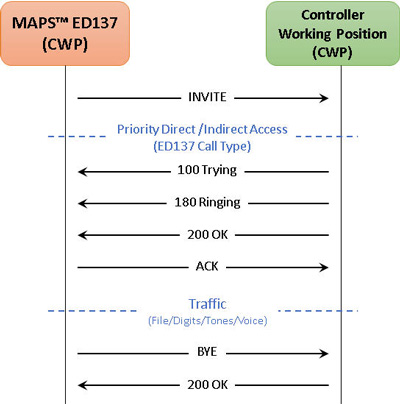
Ground-Ground Call Simulation (as per ED137_2B: Telephone)
MAPS™ ED-137 Telephone can be configured as CWP for placing and receiving calls, thus generating telephone calls.
Once call is established between the two terminals, transmission and detection of various RTP audio traffic such as real-time audio, voice file, digits, single tone and dual tones are also supported with additional licenses.
User-friendly GUI features allows users to manually start/stop traffic, impair the traffic (latency, packetloss, and packeteffect), transfer call, put active call on hold, and playback the call using Speaker On option.
Supported call types includes the following -
- Instantaneous Access
- Priority Direct/Indirect Access
- Routine Tactical Direct/Indirect Access
- Routine Strategic Direct/Indirect Access
- Routine General Purpose Direct/Indirect Access
- Position Monitoring (Combined A/G and G/G, A/G only, and G/G only) Call
 MAPS™ ED-137 Telephone (CWP) |
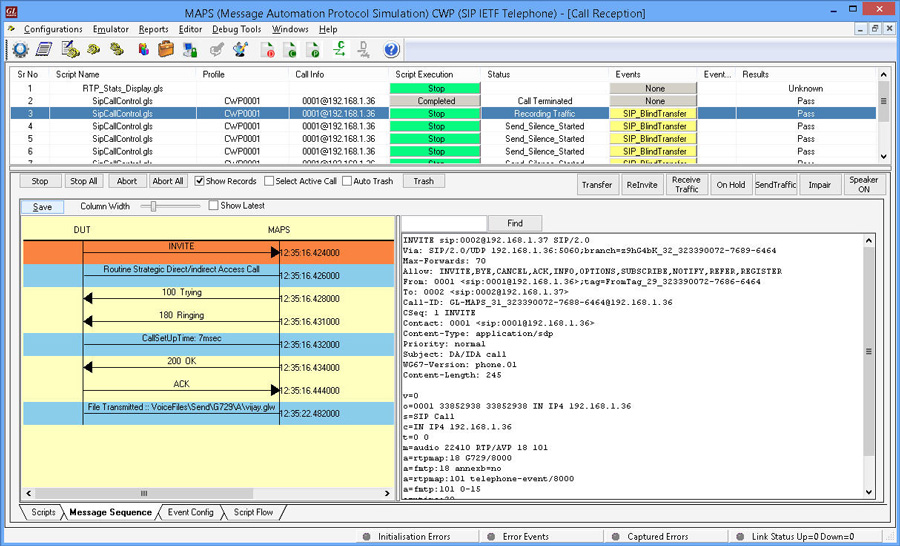 – Routine Strategic Access Call Reception |
MAPS™ ED-137 Telephone Addendums
EUROCAE ED-137C Volume 2 specification describes basic requirements to establish, terminate, and modify speech media sessions of the Ground Telephone Service in an Air Traffic Services Ground Voice Network (AGVN). Along with the basic requirement, it also describes specific call functionalities through number of addendums. GL's MAPS™ ED-137 Telephone is now compliant with addendum 2, addendum 4 and addendum 5 specifications. Support for addendums are optional.
Addendum 2: FAA Legacy Telephone Interworking
Addendum 2 describes the provisions for the FAA Legacy Telephone Interworking, and translation between SIP endpoint(s) and an analog trunk interface to a legacy FAA VCS. The signaling translation between the SIP endpoints and the analog trunk is provided via a gateway. It details the interaction between the analog trunk and the SIP endpoint(s) for five FAA Legacy G/G call types. The supported call types are:
- Legacy Dial-Selective DA/IDA Call
- Legacy Selective Signaling DA/IDA Call
- Legacy Non-Selective DA/IDA Call
- Legacy Voice Call
- Legacy Override (OVR) Call
Sample Call Simulation of Legacy Dial-Selective DA/IDA Call:
This call specifies the signaling interworking of a FAA Legacy Dial-Selective DA/IDA call between SIP endpoint and a Dial-Selective trunk interfacing to a Legacy VCS. To initiate a FAA Legacy Dial-Selective DA/IDA call, the calling party shall establish two-way RTP connectivity to the idle gateway.
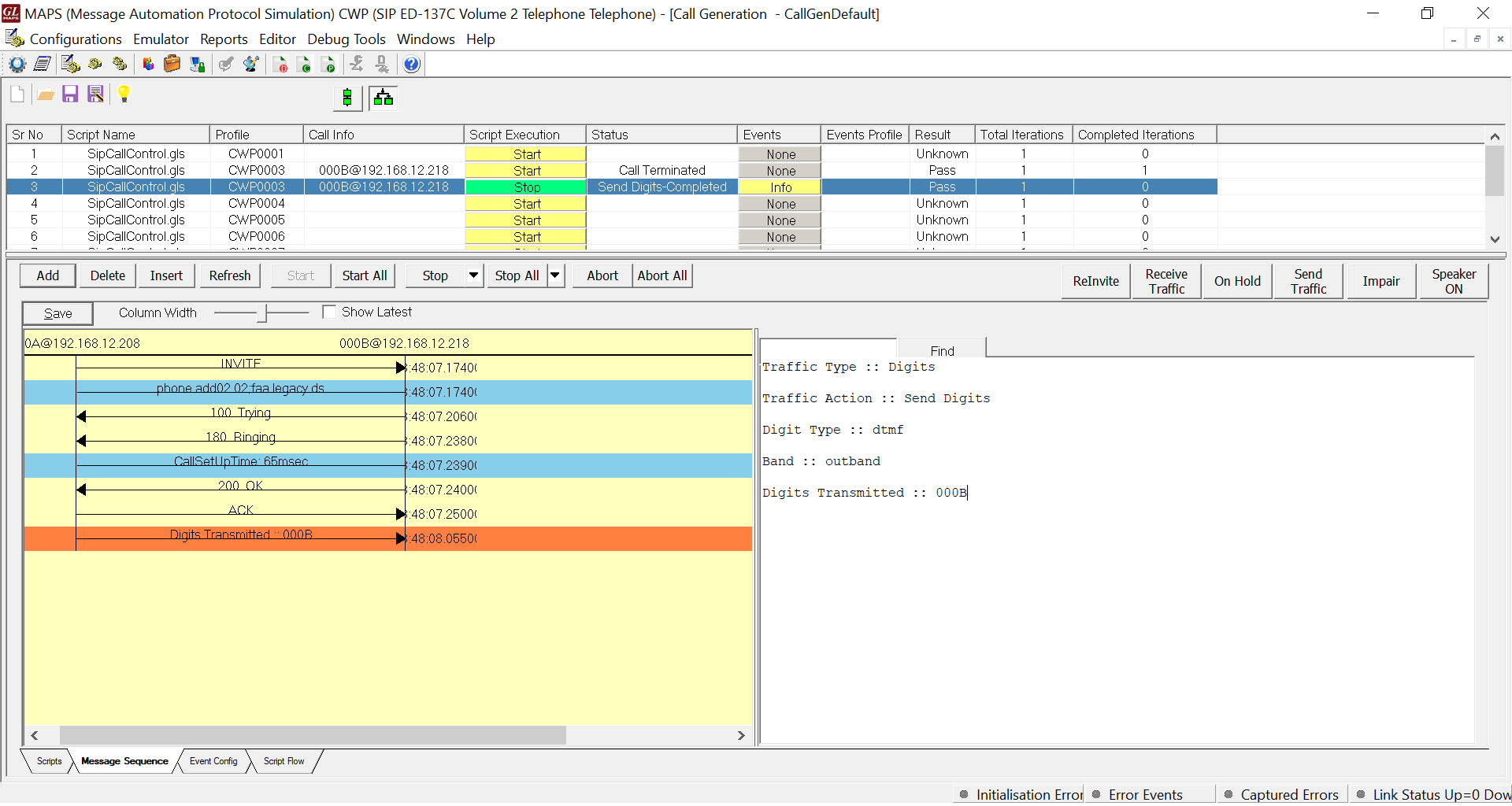
Legacy Dial-Selective DA/IDA Call
Addendum 4: Override Call
Addendum 4 describes the requirements for Override Calls. The Override Call Type is supplemental to the core ED-137C Volume 2 and meant to interact with other call types and features of the core volume; therefore, all applicable requirements established in the core ED-137C: Volume 2 apply to the Override Call Type.
The Override Call Type will provide transmit and receive audio from various call types and as such, will create scenarios where Loop Closure and Echo are to be detected and mitigated. The supported call types are:
- Override Call
- MD Override Call
Sample call simulation of Override call
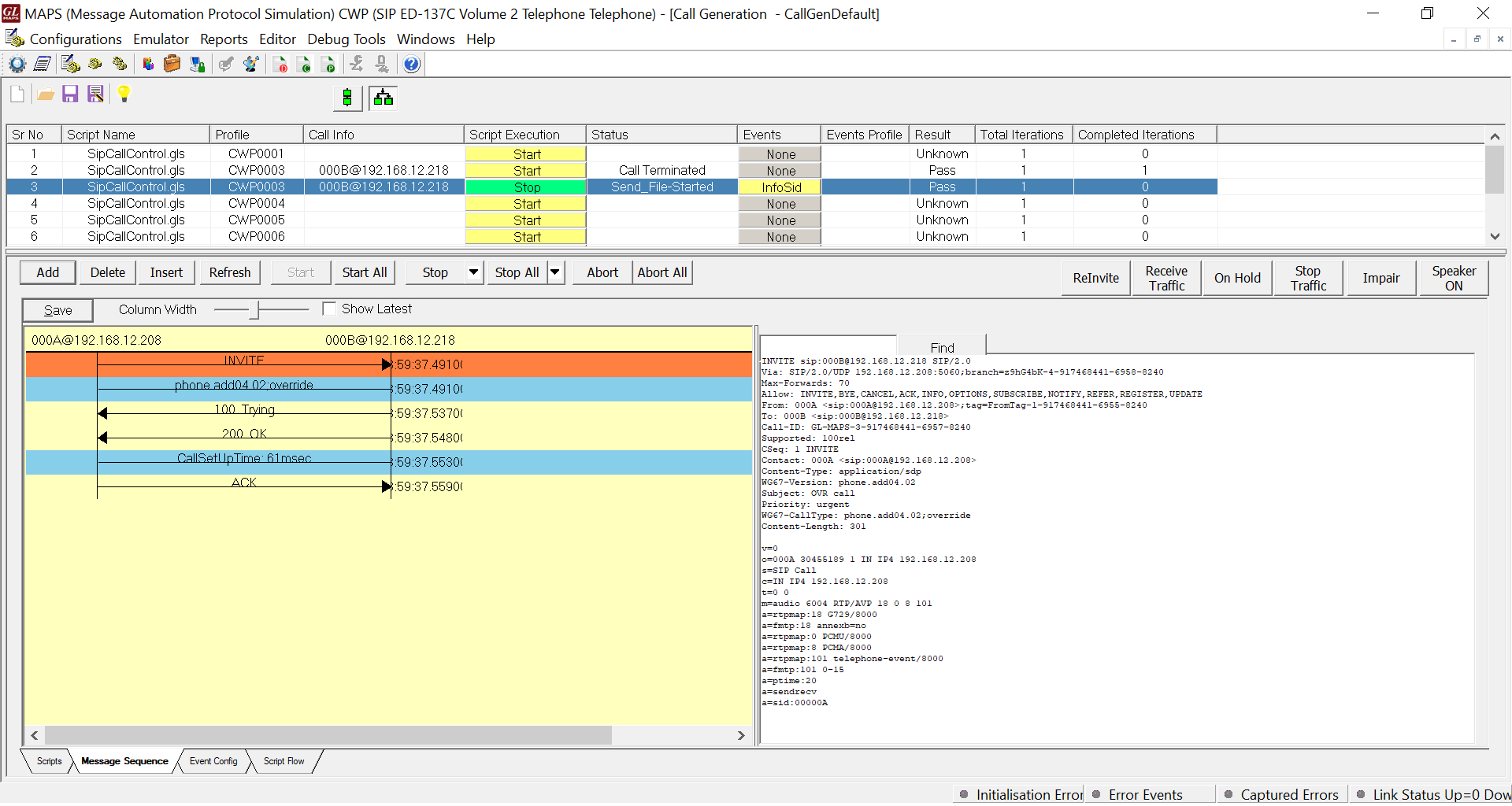
Override call
Sample call simulation of MD Override call
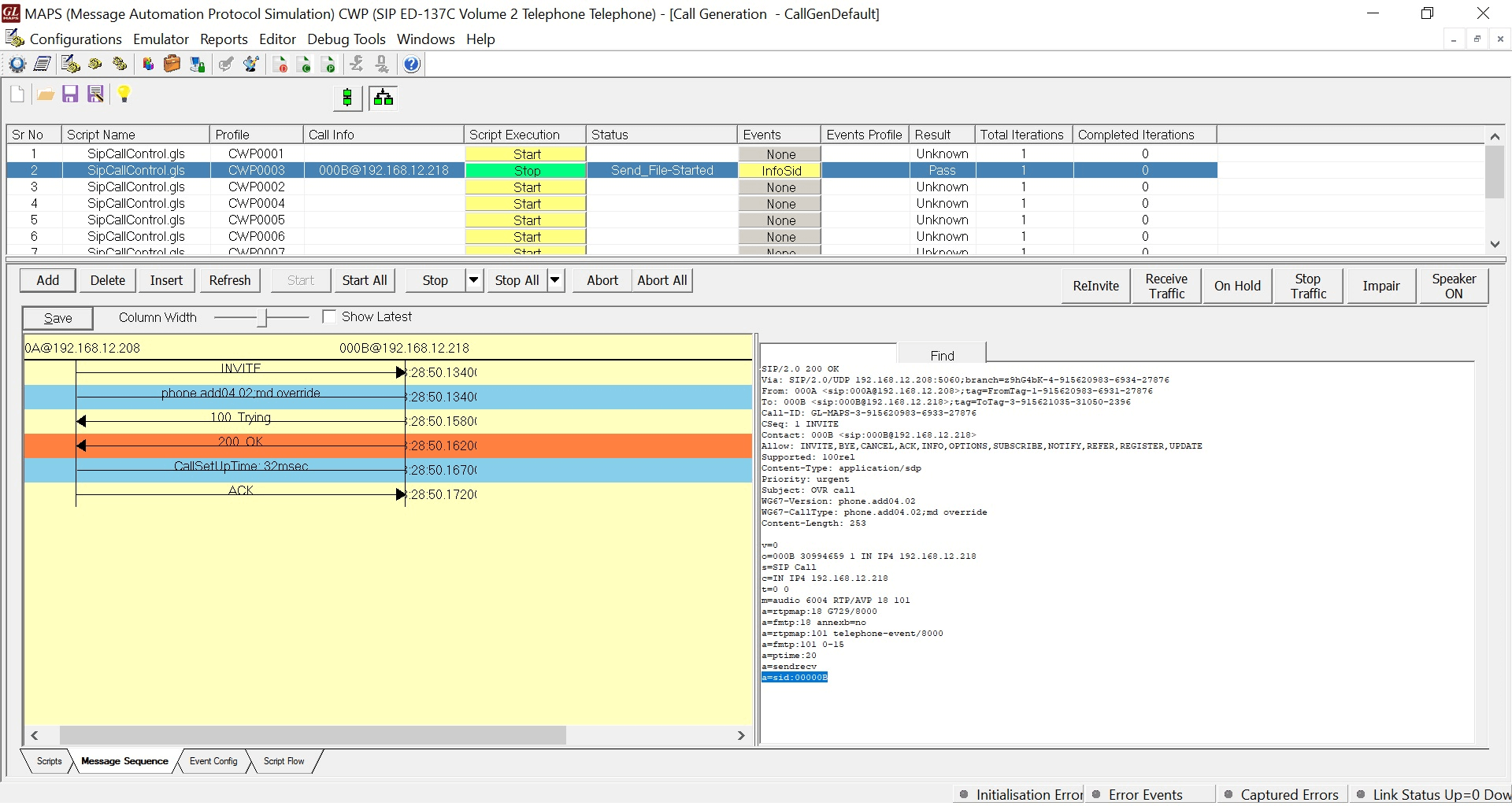
MD Override call
Addendum 5: Voice Call
The Voice call type is supplemental to the core ED-137C Volume 2; therefore, all requirements established in the core ED-137C: Volume 2 apply to the Voice call type unless otherwise specified or superseded. The Voice call type is intended to act as a modified DA/IDA call that forms a new call type to satisfy implementation specific requirements. The Voice call type is initiated as a DA/IDA call.
However, upon initiation the Voice call provides an immediate Voice page from the calling to the called user, replacing ringing tones. The called party of a Voice call answers in the same way as a DA/IDA call and once active, the Voice call is maintained similarly as well. The supported call types are:
- SD Voice Call
- MD Voice Call
Sample call simulation of SD Voice call
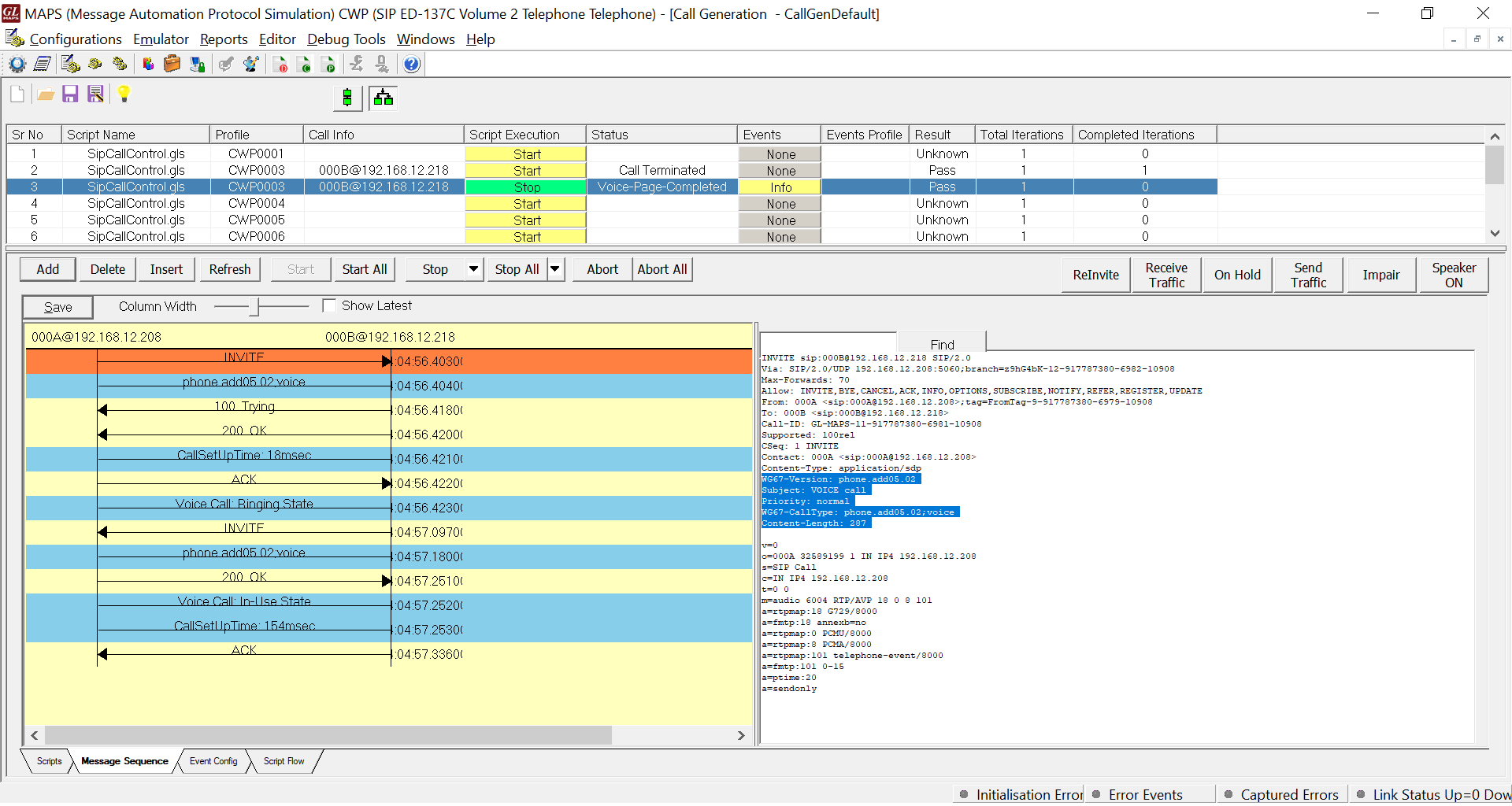
SD Voice call
Sample call simulation of MD Voice call
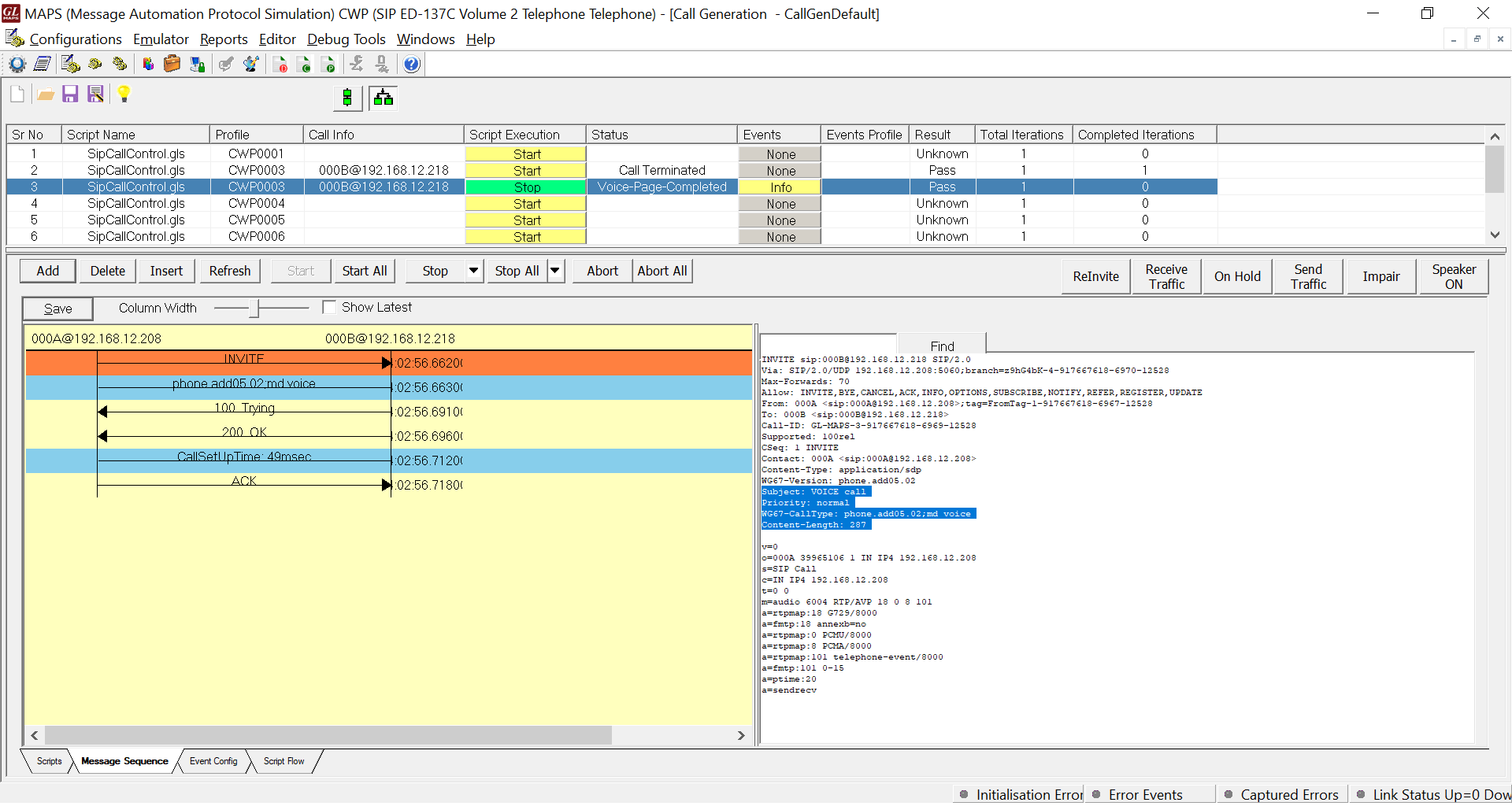
MD Voice call
Additional Call Features
MAPS™ ED-137 Telephone supports below listed additional call features:
- Call Pickup
- Preset Conference
- Broadcast Conference
- Call-Intrusion
Call Pickup
The Call Pickup services enables a user not involved in an early dialog to answer calls on behalf of other parties and may apply to Routine Direct/Indirect Access Calls. The party wishing to pick up the call sends a SUBSCRIBE to the remote entity to retrieve the dialog information. In addition, the party wishing to pick up an early dialog sends an INVITE with a Replaces Header to the calling party.
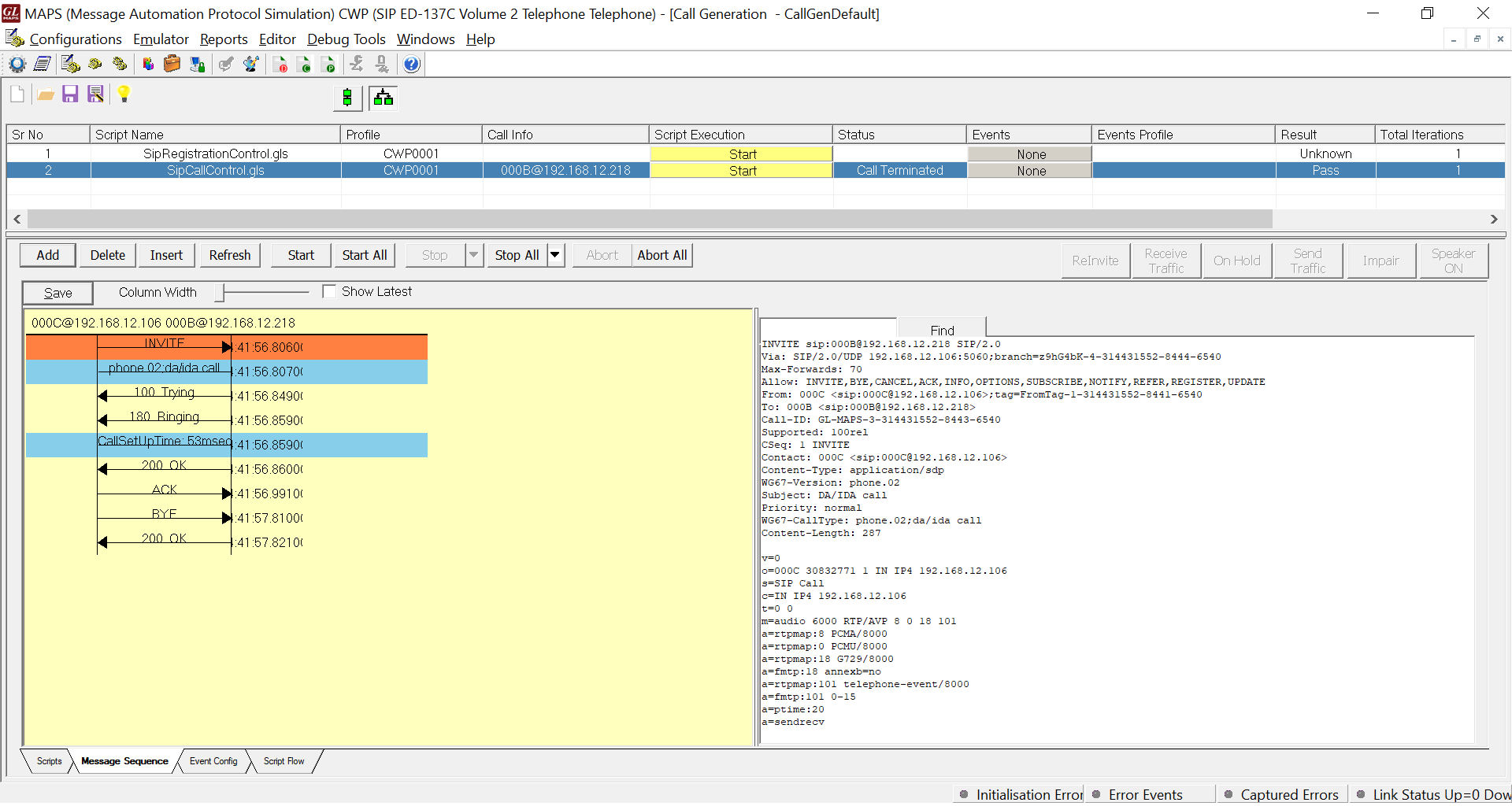
Call Pickup
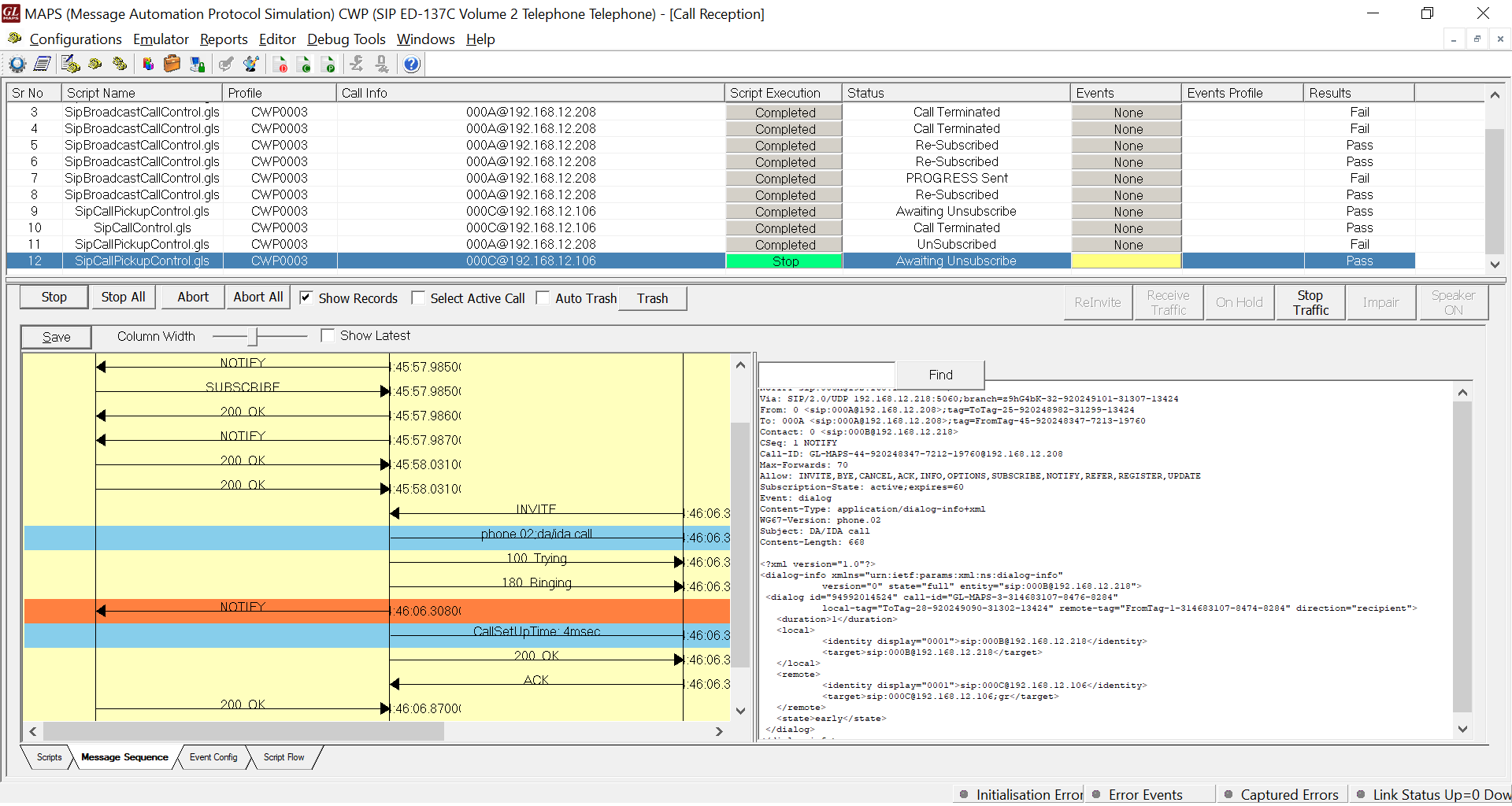
Call Pickup notify
Preset Conference
A Preset Conference call is a Conference call type used to contact all other members assigned to a specific call. The initiating member of a Preset Conference call establishes contact with the call Focus with the intent of contacting the remaining members, via communication with the Focus. The dedicated script i.e. SipPresetCallControl.gls is used to simulate Preset Conference call.

Preset Conference call
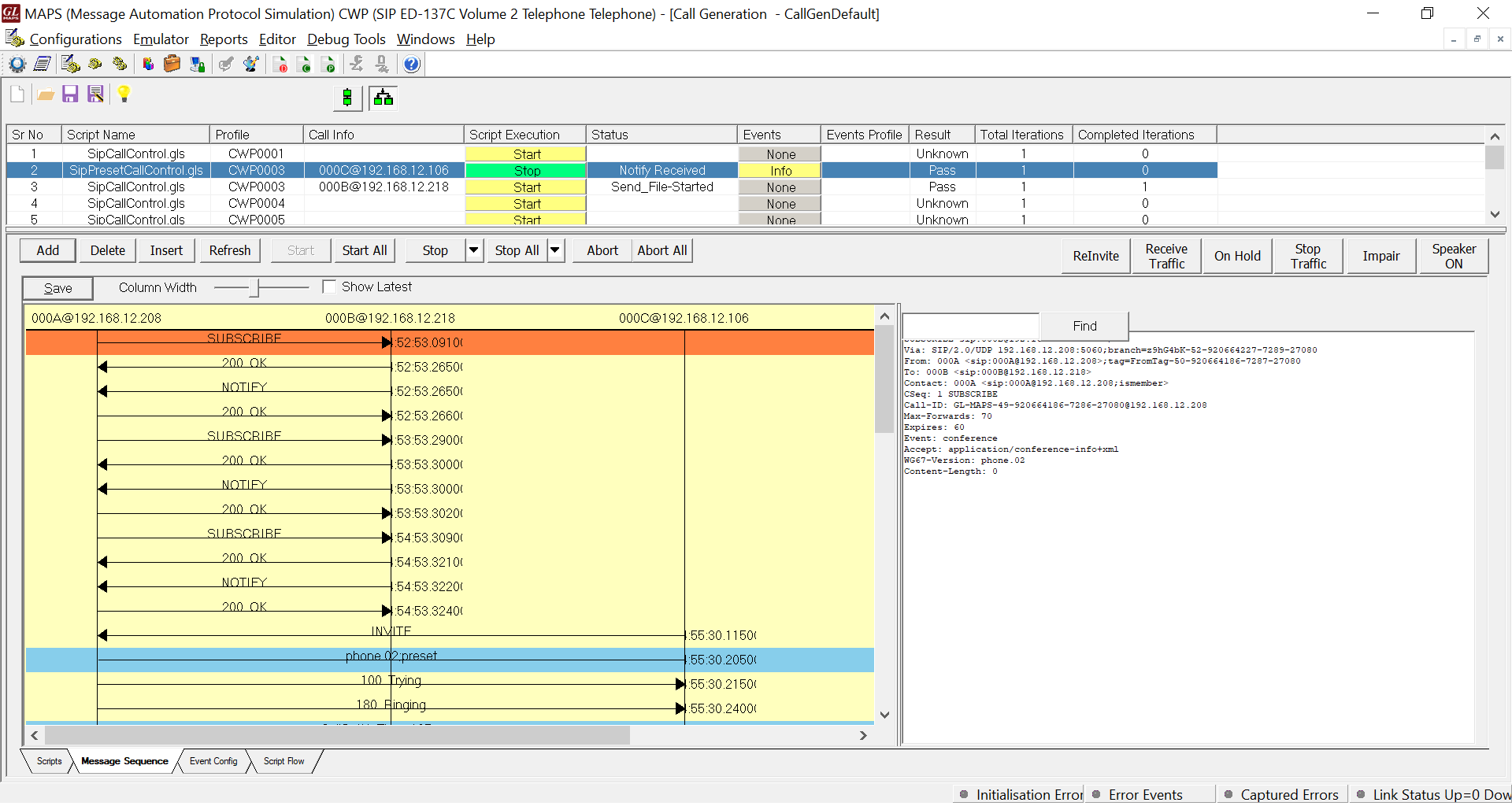
Preset Conference call notify
Broadcast Conference
A Broadcast Conference call is an ad-hoc Conference call where a calling party can dynamically create a conference and add or remove other user agents. The execution of a conference is based on RFC 3891 (“Replaces Header”).
Basically, MAPS act as a SIP end-point and don’t have FOCUS capability. As a SIP user agent, we can establish a SIP session with FOCUS and SUBSCRIBE for a Conference event over the same dialog. User Event option is provided within the established dialog to indicate the FOCUS to Add and Remove conference parties using REFER method. On termination of the call we indicate the Un-Subscription of Conference event to FOCUS by setting Expires value as 0.

Broadcast Conference call - Add Conference Party
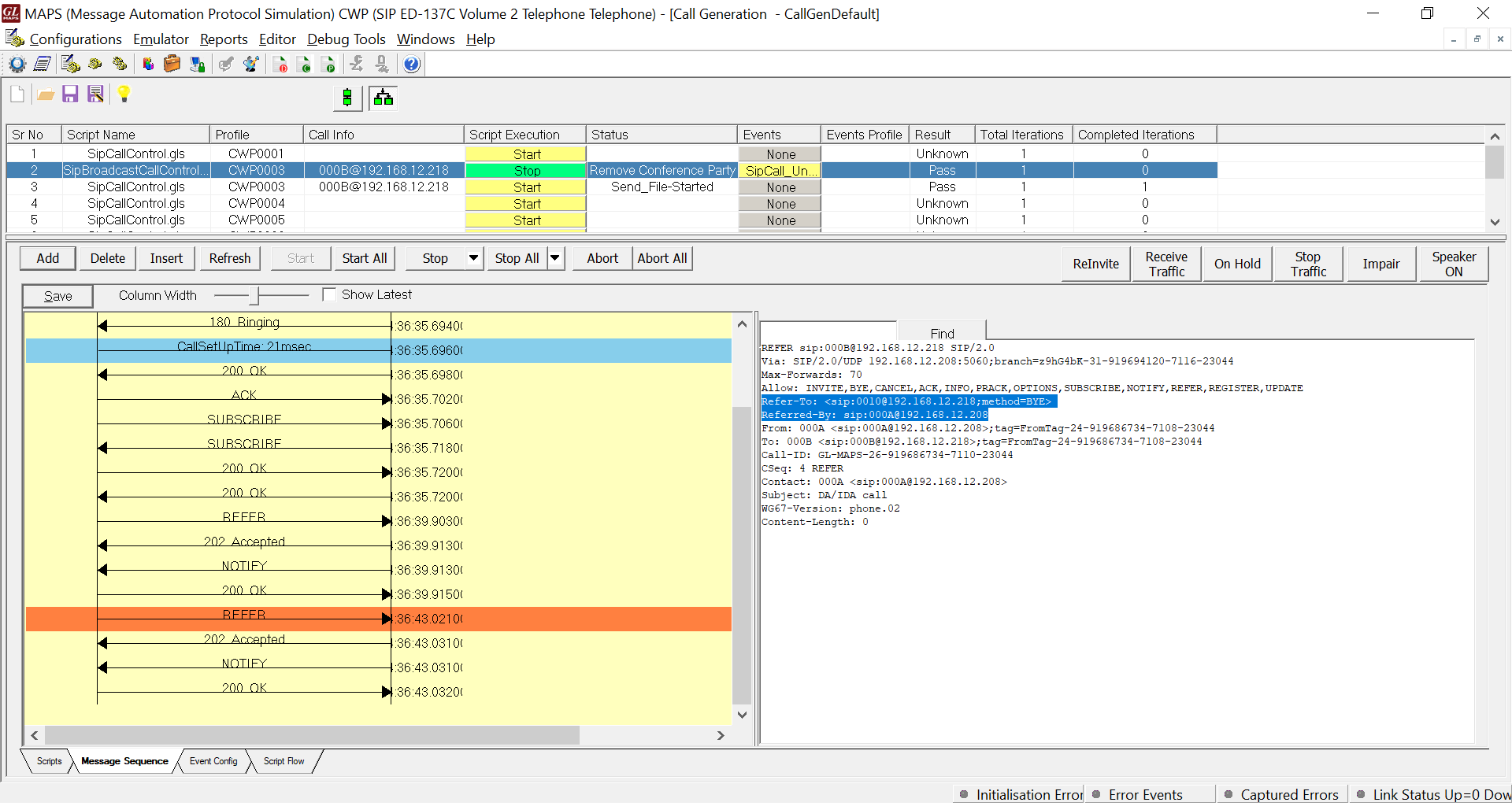
Broadcast Conference call - Remove Conference Party
Call-Intrusion
Call Intrusion ensures prompt addressing of priority calls by automatically joining all parties in a conference if the intended recipient is busy. When encountering a Busy Called UA, priority calls are intruded upon, facilitating immediate communication. Users receive visual and/or audible notifications before intrusion, maintaining awareness. While users can protect themselves from intrusions, call protection settings do not prevent priority call intrusions. This feature enhances communication efficiency by prioritizing critical calls, even in busy scenarios, and provides users with control over their call environment. Basically, MAPS act as a SIP end-point and don’t have FOCUS capability. As a SIP user agent, we can establish SIP sessions with FOCUS.

Call Generation (CWP-000A)
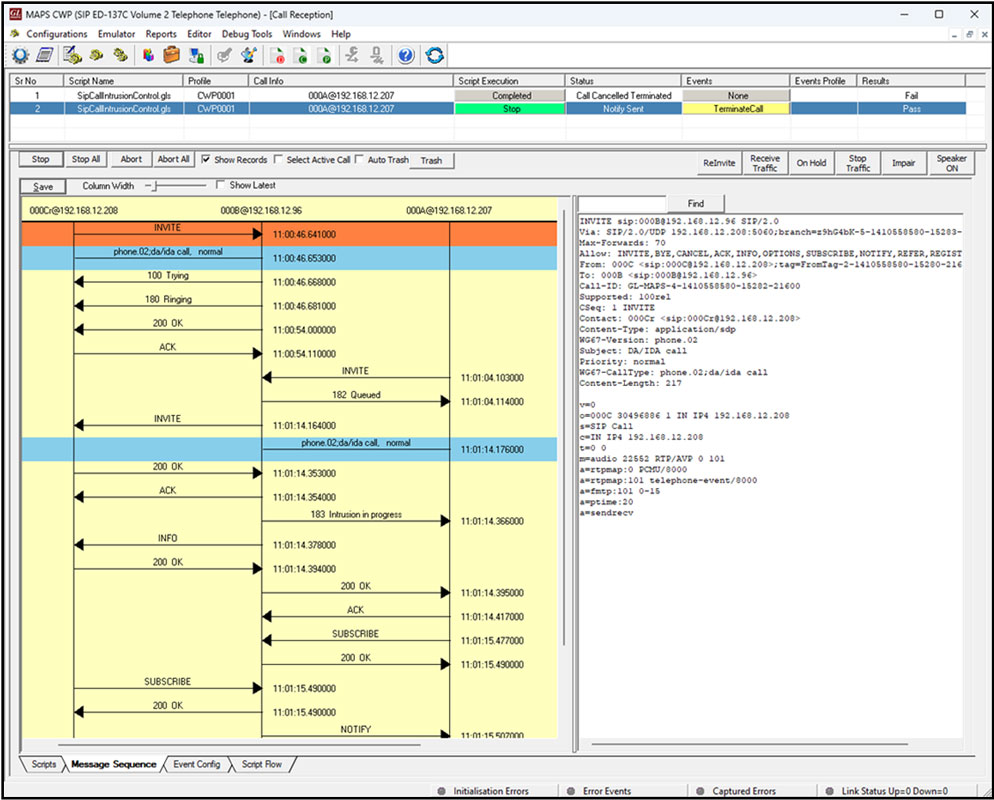
Call Reception (CWP-000B)
Comparison
| MAPS™ ED-137 Radio Simulation | MAPS™ ED-137 Telephone Simulation |
|---|---|
|
|
Resources
Note: PCs which include GL hardware/software require Intel or AMD processors for compliance.
| Item | Air Traffic Management |
|---|---|
| PKS118 | MAPS™ ED-137 Radio (Includes PKS107, & PKS102) |
| PKS119 PK1192 PK1194 PK1195 |
MAPS™ ED-137 Telephone (Includes PKS102) Addendum 2: FAA Legacy Telephone Interworking Addendum 4: Override Call Addendum 5: Voice Call |
| PKS117 | MAPS™ ED-137 Recorder (Includes PKS102) |
| PKS102 | RTP Soft Core for RTP Traffic Generation |
| PKS107 | RTP EUROCAE ED-137 |
